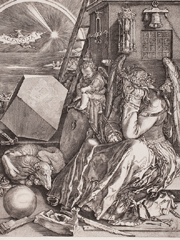Pain, pleasure and the capacity to relate
By uclzean, on 30 May 2014
My first UCL Festival of the Arts lecture began with Tim Matthews (UCL French) and Juliet Mitchell (UCL Psychology & Language Sciences) discussing the relationship between art and psychoanalysis.
Mitchell, a well-known figure in literary criticism and psychoanalysis, has written on sexual difference, hysteria and siblings. Matthews’s work currently focuses on the work of Swiss sculptor Alberto Giacometti.
The talk was introduced as how psychoanalysis uses art and myth in order to find representations of psychic issues. ‘Art is about reaching out to others’, said Matthews, ‘its subjectivity relates to people who aren’t there.’ Psychoanalysis occupies a similar realm it is a client ‘reaching out to people who are not there, the events are in the past’.
Both psychoanalysis and art and indeed life, according to Mitchell, deal with unconscious purposes. ‘We live largely through unconscious processes’, psychoanalysis seeks to find out what those unconscious processes are and art attempts to represent them.
This dates back to Freud’s discovery of how the unconscious works and in his work he sees art and childhood as being important. ‘Artists present unconscious processes’, said Mitchell, therefore, reconfiguring the past in the present.
The talk was engaging throughout. Mitchell, in particular, had an illuminating and intimate knowledge of her subject. At the halfway stage, Tim Matthews told the audience that he was so overwhelmed by the work of sculptor Giacometti that he began to perceive time differently, his vision became clear and so too did his subject.
For a minute, my perception of time had warped as well. The second hand struggled round the clock and speech slackened. The audience shuffled in their seats.
However out-there that statement appeared, his sincerity won the audience over and he went on to explain that Giacometti’s work – stick-like statuettes that dwell in permanent stasis – offer an insight into both the seen and the unseen. They are simultaneously linear and three-dimensional visions of a paradoxical postmodern society. Giacometti’s La Main both embraces and dismisses, for example.
As the audience began to embrace Matthews’s interest in Giacometti, Mitchell began to explain her relationship with the work of Louise Bourgeois. The sculptor’s Maman, an arachnidan, monstrous rendering of the artist’s mother that overarches exhibition spaces, encompassing the consumer, was an ambivalent, sprawling piece, that offers the psychoanalyst an insight into the artist’s psyche.
Indeed, Bourgeois had told Mitchell herself that ‘the artist is a researcher, always searching for the missing piece’. This offered an interesting glimpse into the artist’s own self-styled therapy: the creative act, which by proxy becomes an investigation into the self.
All in all, this was an interesting talk. Some moments were in danger of spilling into the heady swamp of mutual satisfaction but the overall insight into how the artistic and psychoanalytical realms crossover was welcome and informative. Judging on the applause and the few empty seats the audience loved it. I left having learnt a fresh way of approaching sculpture and a new eye for the unseen…
 Close
Close


